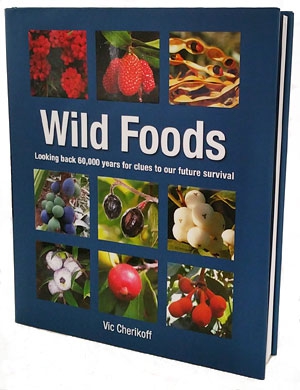
—
The sub-title to the new book by Vic Cherikoff, “Wild Foods – Looking back 60,000 years for clues to our future survival” tells a little of the range of topics covered by the author and those of contributors, Ian Chivers (cropping indigenous Australian grasses) and Izabela Konczak (antioxidant analyses of Australian wild foods).
As global food production and waistlines continue to grow, collective health is going downhill. Hunting for the latest quick fix diet should make it apparent that maybe there is a need to look more closely at how foods themselves have changed over the last 100 years or so and consider a significant overhaul of the food supply.
Wild Foods is the author’s 6th book and it presents a solution to the global epidemics of Metabolic Syndrome and the myriad of other diseases of nutrition. Early chapters explore the consequences of eating modern foods and challenge the notion that they can provide an ideal nutrition. The next portion of Wild Foods discusses the solution; utilizing wild foods to improve health. There are no ‘superfoods’ that are the whole answer to health. No culture survived on one or two ‘special’ foods and health ‘authority’ recommendations of 2 fruits and 5 vegetables a day is not working for anyone today. It is an arsenal of wild foods that protected and supported the world’s longest living culture, that of the Australian Aborigines.
Indigenous Australians living their traditional lifestyle as one of 600 clans across the continent achieved 70 to 80 years of age at a time when Europeans could only get to 40 or 50. Aborigines were polyglots, speaking 3 to 5 languages fluently. They retained an encyclopedic memory of human relationships, foods, medicines, environmental history spanning generations and even the medicines, foods and habits of the animals they hunted for meat. And this information was not just current but spanned many generations and was never written, just remembered from oral communication. Theirs is the longest living culture on the planet spanning some 60,000 years.
The overall themes of the book are disruptive nutrition; disruptive health care; disruptive agriculture; and a possible future role for wild foods. The disease-care industry is tackled head-on. Wild foods can eliminate the need for around 70% of visits to a doctor and also replace a host of pharmaceuticals that they might prescribe, avoiding their unwanted side effects and cost. The Australian Cancer Council highlights a healthy diet as a way to reduce the risk factors of contracting cancer (1 in 2 Australians will be diagnosed with cancer in their lives). Unfortunately, a healthy diet is next to impossible to achieve with modern foods as evidenced by the statistics of people in the developed world who are over-weight or obese and will have diabetes or kidney disease or die of cardiovascular problems.
Diabetes alone will cost the US Government $245 billion next year and rising and the remaining diseases of nutrition might increase this by a factor of 10. The disease-care industry predominantly treats symptoms but wild food nutrition can make many treatments and pharmaceuticals redundant.
Additionally, Wild Foods presents information on peak performance, both mental and physical. The right foods can help those interested in performance to get ‘in the zone’ mentally where related ideas are more easily brought together, outlying concepts become easier to absorb and learning, creativity, decision-making and productivity are all enhanced. In order to age slowly or even reverse some of the signs of time and if longevity is a long term aim, then quality of life must be too. All of these situations require a healthy diet and data from research presented in Wild Foods provides clues as to what ingredients are essential to good health and why.
The agricultural industry which includes the petrochemical industry’s contribution to farm production is also under the lens. Why does society tolerate the falling nutritional quality of food? The use of antimicrobial treatments for soil is a travesty, poisoning the ecosystem and consumers of plants that are effectively produced hydroponically in barren ground. There are better foods that must become dietary staples and there are more responsible ways to produce them. Farmers grow produce that the supermarkets demand and which are often artificially ripened, tough produce able to survive the rigors of distribution chains. These are not high quality foods that are worth eating.
The book is supported by a website (http://www.wildfoodscience.com) which is a work in progress and will continue to expand with on-going updates on information that supports each chapter in the book. Wild Foods can be ordered through any good bookstore or ordered online at (http://tinyurl.com/wildfoodsbook).
Release ID: 91848

